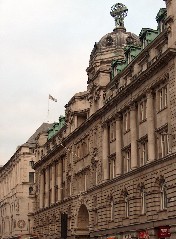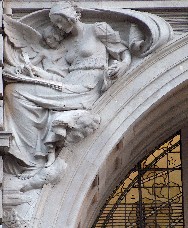 Electra House.
Electra House.
Electra House, no 84 Moorgate, now part of the City of London University, was built as the London headquarters of the Eastern Telegraph and Allied Companies. The architect was John Belcher, and the building was put up shortly after the turn of the century, being completed in 1903. The building bears significant decorative sculpture at five different levels, though at each level the amount of it is relatively small, and the sculpture feels discrete rather than dominant to the viewer of the whole ensemble. But this building brings together Alfred Drury, F. W. Pomeroy, George Frampton and William Goscombe John, a small pantheon of New Sculptors, at the height of their greatest influence.
The building as a whole has a symmetrical façade, centred on the impressive two storey entrance, rising above this to 5 storeys, with a raised central dome above this. Pevsner does not approve. At ground floor level, to the sides of the central doorway in the porch, thus facing each other, are two panels by F. W. Pomeroy, and the scenes are of transmission and reception of telegraphic signals. The central figure for each panel is a particular type of rather burly warrior woman which was favoured at this period by Pomeroy – look at his figures for the Foreign and Colonial Office on Whitehall for a similar style of figures (and see here a piece on warrior women sculpture in general).
 One of the spandrel girls by Frampton.
One of the spandrel girls by Frampton.
Above the door, which once had bronze gates with decoration by Alfred Drury but which I have not been able to see and think have gone – is a colourful stained glass lunette showing a lighthouse, ship, globe etc. To either side of this, against the side of the arch, is an elegant allegorical seated girl. She on the left accompanied by a small angel, is enscribing a messge to be sent; the girl on the right is, I think, receiving it – but the symbolism, while clearly relating to the transmission of messages by means of the telegraph, with wires behind and insulators and electrical apparatus, is obscure. These works are by George Frampton, and the girls are typically graceful, slender, long of neck and high of forehead.
To left and right of the portico are panels showing the company arms, held by pairs of cherubs – these again the work of Frampton.
Upwards two short storeys, directly above the doorway, are four standing figures in high relief, excellent in all respects. They are China, Japan, India and Egypt, and apparently this group was originally to be larger in number, so that we need not be too concerned about this choice. China is a thoughtful girl with a mandolin, wearing long robes and deep sleeves. Japan likewise with long sleeves, and complex designs n her robe, carries a fan, and has flowers behind her. India has lots of jewellery and a loose veil, and Egypt, perhaps the best among strong competition, wears a necklace and tiara of discs, and carries some small pot. All these are by William Goscombe John, and show how excellent was his decorative work, perhaps a surprise when we are so much more familiar with his portrait sculptures.
Level with the heads of these figures, to left and right of the centre of the building, are the capitals of five pillars, thus ten in all. You will need a pair of binoculars to see them properly, but each bears two or three little medieval style figures – nude athletes, a Justice figure, a minstrel, a girl with a water pot, and so forth, and each with its own leaf design on a loosely Corinthian model. Accomplished, interesting work, but who did them?
Higher then, to the fifth floor, with heads of lions, and keystone heads of vaguely Grecian ideal. And then, on top of the dome, a group of four cherubs hold aloft a globe within a wire structure showing the signs of the zodiac. This ensemble is by Pomeroy, and readers of these pages, which do not particularly rejoice in cherubs, may feel a certain relief that they are so high that one can appreciate the general effect without the detail.
Finally, we may mention that inside the entrance hall to the building were murals by George Murray, not a particularly familiar artist, showing communication between the countries, again shown as allegorical girls.
London sculpture // Sculptors // John Belcher
Visits to this page from 13 Mar 2014: 9,818